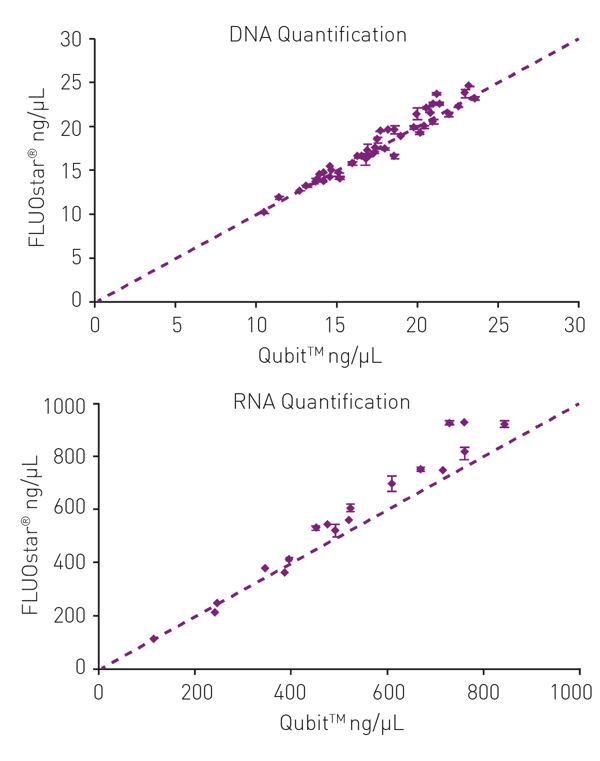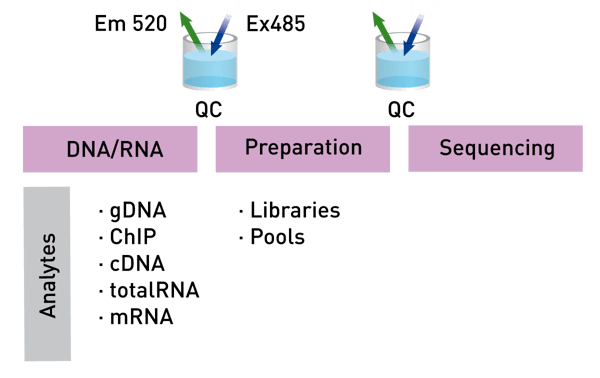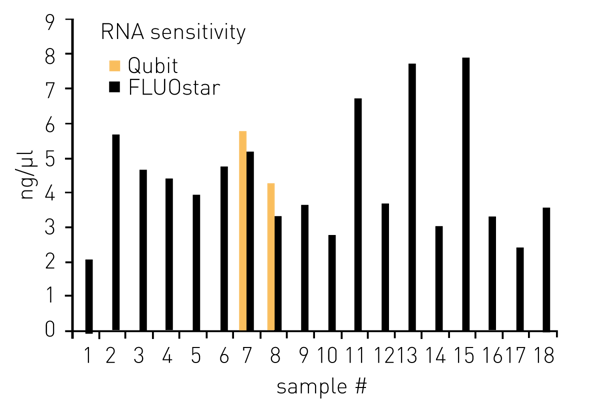Introduction
Next generation sequencing (NGS) technology and applications are rapidly evolving leading to highly increased sampling frequency. Accurate fluorometric quantification of nucleic acids is one of the key qualification parameter in gating samples through the preparation workflow. Given the high and diverse sample number, this represents a major challenge (Figure 1).
Here we show that combining Qubit assays with the FLUOstar® Omega multi-mode plate reader is ideally suited for high-throughput sample quantification that directly impacts the quality of deep sequencing experiments. The assay is fast, precise, and straightforward and can be easily included in automated library preparation systems. Figure 1 represents a typical, quality-controlled NGS workflow. Depending on the assay (WGS, ChIP-Seq, RNA-Seq, etc.) DNA or RNA analytes are fluorometrically quantified and quality, together with integrity parameters, is evaluated. In a second step, sequencing libraries are constructed and successful preparation validated using fluorometric DNA quantification in combination with capillary electrophoresis. Prior sequencing, libraries are pooled to facilitate multiplex sequencing, and pools are loaded on a sequencing instrument for analysis. Percentage of DNA amount of each library in a pool as well as the total amount of DNA loaded on a sequencing instrument directly influences the quality of each sequencing experiment and sequencing run, making precise quantification at any step of the workflow fundamental.
Assay principle
For specific and sensitive fluorometric quantification of a wide range of samples, Qubit assay kits have become gold-standard in NGS applications. The nucleic acid quantification kits provide fluorophores that specifical bind dsDNA or RNA and subsequently enhance their fluorescence. The fluorescence intensity correlates with the amount of dsDNA or RNA and is used to calculate the nucleic acid concentration. Qubit chemistry is typically detected directly in a sample tube on a Qubit fluorometer. Therefore, Qubit cannot be integrated into an automatic workflow. Transfer of the reaction to a microplate opens the possibility to use the Qubit fluorescent dyes for automated nucleic acid quantification.
Materials & Methods
- Qubit dsDNA HS Assay (ThermoScientific, Q32854))
- Qubit RNA HS Assay (ThermoScientific, Q32855)
- Qubit RNA BR Assay (ThermoScientific, Q10210)
- Qubit Assay tubes (ThermoScientific, Q32856)
- 96-well plates, black, F-bottom (Greiner bio-one, 655076)
- Qubit® single tube fluorometer (ThermoScientific), FLUOstar® Omega (BMG LABTECH)
Experimental procedure
DNA/RNA samples were diluted with the respective Qubit® working solution either in Qubit® assay tubes or into 96-well microplates. Measurement volume was for all assays 200 µl including a 10 µl standard and 2 µl or 1 µl sample. In microplates samples and Qubit working solution were mixed by pipetting using a 300 µl 8-channel pipette. After 2 minutes incubation, fluorescence intensity was detected using the FLUOstar Omega multi-mode plate reader (BMG LABTECH) or the Qubit® single tube fluorometer. In case of the FLUOstar Omega, data was exported as standard excel.
Instrument settings
|
Optic settings
|
Fluorescence intensity, top optic, endpoint
|
|
|
Filters
|
DNA
Ex: 485 Em: 520 Gain: 1100
|
|
|
RNA
Ex: 630-10
Em: 670-10 Gain: 2600 |
||
|
General settings
|
Number of flashes
|
20
|
|
Setting time
|
0.5 s
|
|
Results & Discussion
DNA sequencing libraries and total RNA samples were quantified using the FLUOstar Omega microplate reader or the Qubit® single tube fluorometer. Plate reader measurements were conducted in duplicate and the standard deviation of technical replicates automatically calculated using the MARS analysis software package. For both, DNA and RNA quantification, measurements agree very well between the different fluorescence detection devices (Figure 2). The FLUOstar Omega enables simple replicate analysis thus enhancing measurement precision. Quantification assays can easily be carried out using multichannel pipetting to increase throughput and enable seamless integration into liquid handling systems.
 Scarce samples (low volume, low concentration) are typical challenges for accurate quantification. We compared quantification of rare (low input/low volume) RNA samples on both the FLUOstar Omega multi-mode plate reader and the Qubit® single tube fluorometer. While the Qubit instrument only measured concentration in a fraction of the analyzed samples the plate reader detected RNA concentration in all measured samples (sample volume for measurement: 1 µl) demonstrating superior sensitivity.
Scarce samples (low volume, low concentration) are typical challenges for accurate quantification. We compared quantification of rare (low input/low volume) RNA samples on both the FLUOstar Omega multi-mode plate reader and the Qubit® single tube fluorometer. While the Qubit instrument only measured concentration in a fraction of the analyzed samples the plate reader detected RNA concentration in all measured samples (sample volume for measurement: 1 µl) demonstrating superior sensitivity.
Conclusion
The NGS sample preparation laboratories are conducting nucleic acid quantification assays on a daily basis but technology that provides adequate throughput and precision remain a challenge.
Here we show that combination of Qubit assays with the FLUOstar Omega multi-mode microplate reader is ideally suited to measure a wide range of nucleic acids and improves compared to the single tube fluorometer on sensitivity, precision, and speed. Especially large laboratories that perform automated high throughput sample preparation will profit from this technology.



